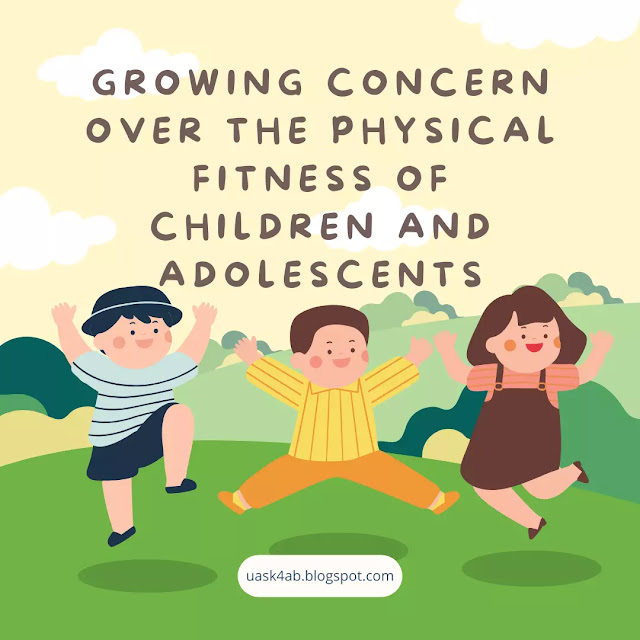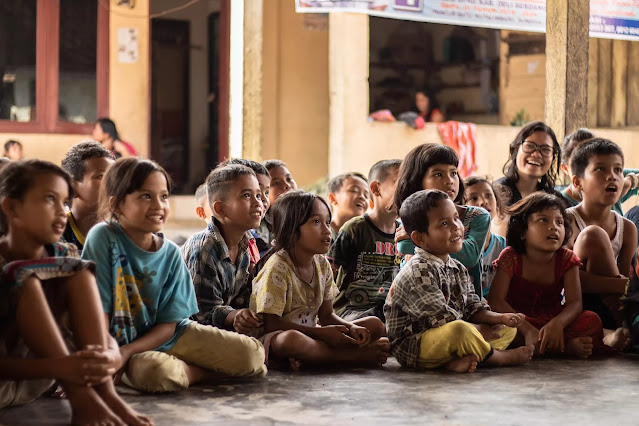Physical fitness is an essential component of a healthy lifestyle, and it is vital for children and adolescents to develop good fitness habits early on in life. However, there has been a growing concern over the physical fitness of children and adolescents in recent years, and the statistics are alarming.
According to a report from the World Health Organization (WHO), approximately 80% of adolescents worldwide are not getting enough physical activity. In the United States, the Centers for Disease Control and Prevention (CDC) reports that only one in four children gets the recommended one hour of physical activity per day.
This lack of physical activity can have serious consequences on the health and well-being of children and adolescents. Studies have shown that children who do not engage in regular physical activity are at a higher risk of developing chronic health conditions such as obesity, type 2 diabetes, and cardiovascular disease.
Furthermore, the lack of physical activity can have negative effects on mental health, including anxiety, depression, and low self-esteem.
The importance of physical fitness in children and adolescents cannot be overstated. Regular physical activity helps children develop strong bones and muscles, improves balance and coordination, and promotes healthy growth and development.
In addition, physical activity can help children and adolescents develop important social skills and self-confidence, which can have a positive impact on their overall quality of life.
Therefore, it is crucial that parents, educators, and policymakers prioritize physical fitness in children and adolescents, and take steps to encourage and promote physical activity in all aspects of daily life.
Furthermore, a study by the American Heart Association found that only 1 in 5 children in the United States meet the recommended levels of physical activity. These statistics highlight the urgent need to address the issue of physical fitness in children and adolescents.
Physical fitness is essential for children and adolescents as it is critical to their overall health and development. Regular physical activity can help children and adolescents maintain a healthy weight, reduce the risk of chronic diseases, improve their mental health, and build strong bones and muscles.
Physical fitness also plays a significant role in developing healthy habits that can last a lifetime. As such, it is crucial for parents, educators, and policymakers to prioritize physical fitness in children and adolescents.
What is Physical Fitness?
Physical fitness refers to the ability of an individual to perform physical activities with ease and without experiencing undue fatigue or physical stress. Physical fitness is characterized by several key features, including:
Aerobic fitness
Aerobic fitness refers to the body's ability to perform activities that require oxygen, such as running, cycling, or swimming. Individuals with high levels of aerobic fitness have a strong cardiovascular system, enabling them to perform these activities for extended periods of time.
Muscular strength
Muscular strength refers to the ability of the muscles to generate force. Individuals with high levels of muscular strength have a greater capacity for activities that require lifting or carrying heavy objects.
Muscular endurance
Muscular endurance refers to the ability of the muscles to perform repeated contractions over an extended period of time. Individuals with high levels of muscular endurance can perform activities such as push-ups or sit-ups for extended periods of time.
Flexibility
Flexibility refers to the ability of the joints and muscles to move through a full range of motion. Individuals with high levels of flexibility have a reduced risk of injury and better posture.
Body composition
Body composition refers to the proportion of lean mass (muscle, bone, and organs) to fat mass in the body. Individuals with a healthy body composition have a lower risk of chronic diseases such as diabetes and heart disease.
Balance and coordination
Balance and coordination are important components of physical fitness, allowing individuals to perform activities that require precision and accuracy, such as dancing or martial arts.
Physical fitness is an important aspect of overall health and well-being and is associated with reduced risk of chronic diseases such as obesity, diabetes, and heart disease. Engaging in regular physical activity that includes a combination of aerobic exercise, strength training, and flexibility exercises can improve physical fitness and promote better health outcomes.
The Stage of Childhood and Adolescent
Childhood and adolescence are two distinct stages of development in human life that are characterized by a variety of physical, cognitive, and emotional changes. Childhood typically ranges from birth to around 12 years of age, while adolescence lasts from around 12 to 18 years of age.
Childhood and adolescence are two distinct stages of development that are characterized by significant physical changes and a growing interest in physical fitness. In both stages, physical fitness plays a critical role in overall health and well-being, and it is important to understand the characteristics of these stages in relation to physical fitness.
Characteristics of Childhood
- Rapid Growth and Development: Childhood is a time of rapid growth and development, with infants growing rapidly in the first year of life and children becoming more coordinated and developing gross and fine motor skills.
- Increased Physical Activity: Children are naturally active and enjoy physical activities such as running, jumping, and playing. They may participate in organized sports, physical education classes, and other physical activities that promote physical fitness.
- Importance of Play: Play is a crucial aspect of childhood development and can help children develop physical fitness and other skills. Activities such as climbing, jumping, and running can help build strength, coordination, and endurance.
- Limited Attention Span: Children have limited attention spans and may struggle to engage in structured exercise routines for extended periods. It is important to make physical activity fun and engaging for children to maintain their interest and participation.
- Varied Interests: Children have varied interests, and it is important to provide opportunities for physical fitness that cater to these interests. For example, a child who enjoys dance may benefit from dance classes, while a child who enjoys team sports may benefit from joining a sports team.
Characteristics of Adolescence
- Rapid Growth and Development: Adolescents experience significant growth and development, with a rapid increase in height and hormonal changes that impact physical fitness.
- Increased Importance of Physical Appearance: Adolescents may become more self-conscious about their physical appearance and place a greater emphasis on physical fitness to improve their appearance.
- Increased Participation in Organized Sports: Adolescents may participate in organized sports and physical education classes that promote physical fitness and may even specialize in one or two sports.
- Greater Capacity for Structured Exercise: Adolescents have a greater capacity for structured exercise routines and may benefit from weightlifting, cardio workouts, and other structured exercise programs.
- Peer Influence: Peers play an important role in adolescent development, including physical fitness. Adolescents may be influenced by their peers to participate in physical fitness activities or to improve their physical appearance.
Why is There a Growing Concern Over the Physical Fitness of Children and Adolescents?
Childhood obesity, sedentary lifestyles, and poor nutrition have become major health concerns for children and adolescents worldwide. The physical fitness of children and adolescents is declining at an alarming rate, and this is a cause for concern. According to the World Health Organization, childhood obesity has increased dramatically in the last few decades, with the number of overweight children and adolescents rising from 31 million in 1990 to 124 million in 2016.
Sedentary Lifestyle and Its Effect on Children's Health
A sedentary lifestyle refers to a lack of physical activity or exercise, where individuals spend a significant amount of time sitting or lying down, such as watching TV or playing video games. Unfortunately, sedentary behaviour has become increasingly prevalent among children and adolescents in recent years.
According to the CDC, children between the ages of 8 and 18 spend an average of 7.5 hours per day using electronic devices for entertainment purposes, such as watching TV, playing video games, or using a computer. This sedentary behaviour can have negative effects on children's health.
The impact of sedentary behaviour on children's health includes an increased risk of obesity, cardiovascular disease, and type 2 diabetes. Additionally, children who spend more time sitting and less time engaging in physical activity may experience a delay in their physical development, as well as poor bone and joint health.
Reducing sedentary behaviour in children is crucial to their physical and mental health. Encouraging children to engage in physical activity and limiting screen time can be effective ways to reduce sedentary behaviour. Parents can promote physical activity by encouraging their children to participate in sports or outdoor activities, taking family walks or bike rides, and limiting screen time to no more than two hours per day.
Educators can also play a role in reducing sedentary behaviour by incorporating physical activity into classroom routines, such as brain breaks, physical education classes, and active learning strategies.
Poor Nutrition and Its Effect on Children's Health
Poor nutrition refers to a diet that lacks the necessary nutrients, vitamins, and minerals required for a healthy body. Unfortunately, poor nutrition is prevalent among children and adolescents in many parts of the world.
According to the WHO, globally, around 45% of deaths among children under five years of age are linked to malnutrition. In the United States, over 20% of children live in households that are food insecure, which means that they do not have access to enough food for an active and healthy lifestyle.
The impact of poor nutrition on children's health includes stunted growth and development, a weakened immune system, and an increased risk of chronic diseases such as obesity and type 2 diabetes.
Improving nutrition in children is essential for their health and well-being. Here are some ways to improve nutrition in children:
- Encouraging children to eat a balanced diet with plenty of fruits, vegetables, whole grains, and lean proteins.
- Limiting processed and sugary foods and drinks.
- Encouraging children to drink water instead of sugary drinks.
- Promoting family meals and eating together as a family.
- Teaching children about healthy food choices and cooking skills.
- Ensuring that children have access to healthy food options at school.
Lack of Physical Education in Schools and Its Effect on Children's Health
Physical education (PE) in schools plays a vital role in promoting physical activity and a healthy lifestyle among children and adolescents. However, many schools around the world have reduced or eliminated PE programs due to budget cuts, academic pressure, and other factors, leading to a lack of physical education in schools.
According to the CDC, only 24% of high school students participate in daily physical education classes, and 37 states in the United States do not require schools to provide physical education. This lack of physical education can have negative effects on children's health.
The impact of the lack of physical education on children's health includes an increased risk of obesity, poor cardiovascular health, and weaker bones and muscles.
Additionally, children who do not engage in regular physical activity may experience mental health issues such as anxiety and depression.
Increasing physical education in schools is crucial to promoting a healthy and active lifestyle among children and adolescents. Here are some ways to increase physical education in schools:
- Providing daily physical education classes for all students.
- Incorporating physical activity into classroom routines, such as brain breaks and active learning strategies.
- Offering a variety of physical activity options, such as team sports, dance, and yoga.
- Providing professional development opportunities for PE teachers to ensure that they have the necessary knowledge and skills to promote physical activity.
- Advocating for policy changes that require schools to provide physical education and allocate sufficient funding for PE programs.
Effects of Physical Fitness on Mental Health
The relationship between physical fitness and mental health is well-established. Regular physical activity has been shown to have positive effects on mental health, including reducing the risk of depression, anxiety, and other mental health disorders.
According to the CDC, 1 in 6 children between the ages of 2 and 8 years old has a diagnosed mental, behavioural, or developmental disorder. Additionally, suicide is the second leading cause of death among adolescents aged 15 to 19 years.
The impact of physical fitness on mental health in children and adolescents is significant. Regular physical activity can reduce the symptoms of anxiety and depression, improve mood, and increase self-esteem and confidence. Physical activity can also provide a healthy outlet for stress and emotions.
Ways to improve mental health through physical fitness include:
- Encouraging children to engage in regular physical activity, such as team sports, running, swimming, and dancing.
- Making physical activity fun and enjoyable for children, such as playing games or incorporating music into workouts.
- Encouraging children to spend time outside in nature, has been shown to have positive effects on mental health.
- Incorporating mindfulness and relaxation techniques into physical activity, such as yoga or meditation.
- Providing access to mental health resources and support for children who may be struggling with mental health issues.
The effects of physical fitness on mental health in children and adolescents are significant. Encouraging regular physical activity, making it enjoyable, and incorporating mindfulness and relaxation techniques can all help to improve mental health. Additionally, providing access to mental health resources and support is crucial for children who may be struggling with mental health issues.
RELATED POSTS
Final Thought
The physical fitness of children and adolescents is a growing concern, with sedentary lifestyles, poor nutrition, lack of physical education in schools, and mental health issues all contributing to the problem. It is crucial to address these issues and prioritize physical fitness to promote a healthy and active lifestyle among children and adolescents.
Regular physical activity, healthy nutrition, and access to mental health resources can have significant positive effects on children's physical and mental health. Parents, educators, and policymakers all have a role to play in addressing this issue and promoting physical fitness among children and adolescents.
We must prioritize physical fitness in schools and communities and create environments that encourage and support healthy habits. By doing so, we can improve the overall health and well-being of children and adolescents and set them on a path to a healthy and active lifestyle.















.webp)

.webp)
